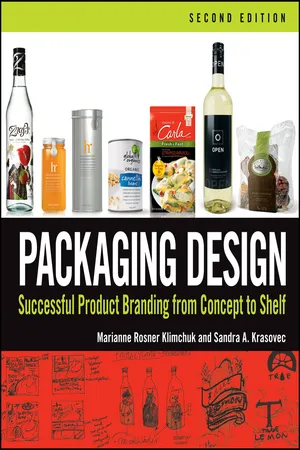
Packaging Design
Successful Product Branding From Concept to Shelf
- English
- ePUB (mobile friendly)
- Available on iOS & Android
Packaging Design
Successful Product Branding From Concept to Shelf
About this book
The fully updated single-source guide to creating successful packaging designs for consumer products
Now in full-color throughout, Packaging Design, Second Edition has been fully updated to secure its place as the most comprehensive resource of professional information for creating packaging designs that serve as the marketing vehicles for consumer products. Packed with practical guidance, step-by-step descriptions of the creative process, and all-important insights into the varying perspectives of the stakeholders, the design phases, and the production process, this book illuminates the business of packaging design like no other.
Whether you're a designer, brand manager, or packaging manufacturer, the highly visual coverage in Packaging Design will be useful to you, as well as everyone else involved in the process of marketing consumer products. To address the most current packaging design objectives, this new edition offers:
- Fully updated coverage (35 percent new or updated) of the entire packaging design process, including the business of packaging design, terminology, design principles, the creative process, and pre-production and production issues
- A new chapter that puts packaging design in the context of brand and business strategies
- A new chapter on social responsibility and sustainability
- All new case studies and examples that illustrate every phase of the packaging design process
- A history of packaging design covered in brief to provide a context and framework for today's business
- Useful appendices on portfolio preparation for the student and the professional, along with general legal and regulatory issues and professional practice guidelines
Frequently asked questions
- Essential is ideal for learners and professionals who enjoy exploring a wide range of subjects. Access the Essential Library with 800,000+ trusted titles and best-sellers across business, personal growth, and the humanities. Includes unlimited reading time and Standard Read Aloud voice.
- Complete: Perfect for advanced learners and researchers needing full, unrestricted access. Unlock 1.4M+ books across hundreds of subjects, including academic and specialized titles. The Complete Plan also includes advanced features like Premium Read Aloud and Research Assistant.
Please note we cannot support devices running on iOS 13 and Android 7 or earlier. Learn more about using the app.
Information
Chapter 1
The History

Neolithic jar.

Pictographics, naos of the temple at Ed Dakka, Egypt.
Close examination of the image of an interior temple wall reveals the visual identification of goods by pictorial representation.

Symbol for wheat.
The Sumerian symbol for wheat is one of the earliest examples of an icon used for visual communication.

Early letterforms.
The Growth of Trade
Table of contents
- Cover
- Table of Contents
- Title
- Copyright
- Preface
- Acknowledgments
- Chapter 1: The History
- Chapter 2: Defining Packaging Design
- Chapter 3: Elements of the Packaging Design
- Chapter 4: The Design Process
- Chapter 5: The Packaging Design Profession
- Glossary
- APPENDIX A: Consumer Product Categories
- APPENDIX B: Materials and Tools
- Bibliography
- Professional Credits
- Figure Credits
- Index
- End User License Agreement